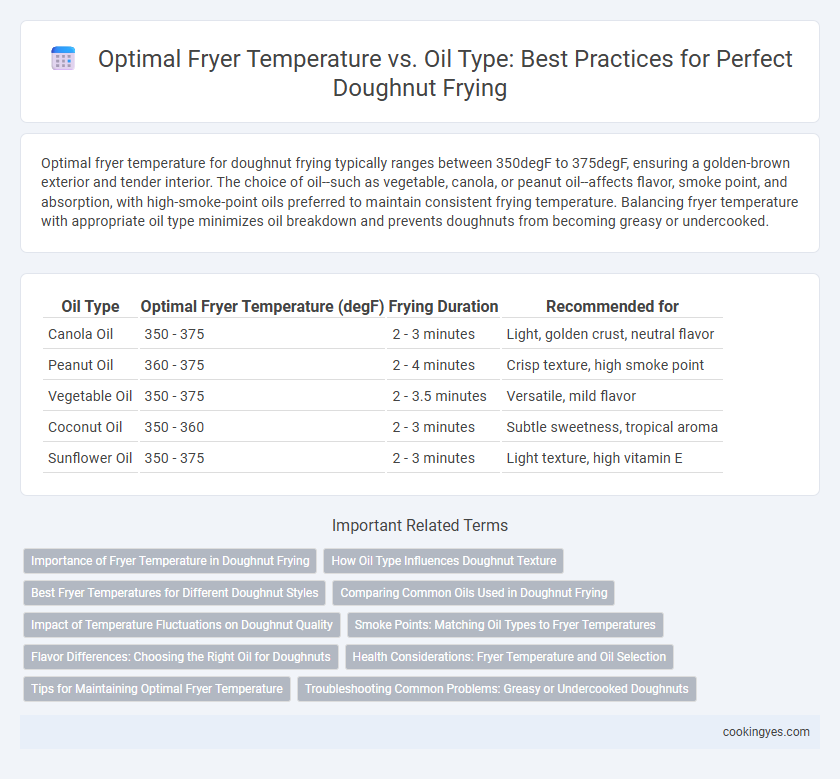Optimal fryer temperature for doughnut frying typically ranges between 350degF to 375degF, ensuring a golden-brown exterior and tender interior. The choice of oil--such as vegetable, canola, or peanut oil--affects flavor, smoke point, and absorption, with high-smoke-point oils preferred to maintain consistent frying temperature. Balancing fryer temperature with appropriate oil type minimizes oil breakdown and prevents doughnuts from becoming greasy or undercooked.
Table of Comparison
| Oil Type | Optimal Fryer Temperature (degF) | Frying Duration | Recommended for |
|---|---|---|---|
| Canola Oil | 350 - 375 | 2 - 3 minutes | Light, golden crust, neutral flavor |
| Peanut Oil | 360 - 375 | 2 - 4 minutes | Crisp texture, high smoke point |
| Vegetable Oil | 350 - 375 | 2 - 3.5 minutes | Versatile, mild flavor |
| Coconut Oil | 350 - 360 | 2 - 3 minutes | Subtle sweetness, tropical aroma |
| Sunflower Oil | 350 - 375 | 2 - 3 minutes | Light texture, high vitamin E |
Importance of Fryer Temperature in Doughnut Frying
Maintaining the correct fryer temperature, typically between 350degF and 375degF, is crucial for achieving the perfect doughnut texture and preventing oil absorption. Different oils, such as canola, peanut, or vegetable oil, have varying smoke points that influence their suitability for high-temperature frying without breaking down. Consistent temperature control ensures even cooking, a golden-brown exterior, and minimizes the risk of greasy or undercooked doughnuts.
How Oil Type Influences Doughnut Texture
The type of oil used in doughnut frying significantly influences texture, as oils with higher smoke points like peanut or canola oil enable frying at optimal temperatures around 350-375degF, producing a crisp exterior and soft interior. Oils with lower smoke points often degrade quickly, leading to greasy, overly dense doughnuts due to uneven frying temperatures. Proper oil selection ensures consistent heat transfer, preserving doughnut lightness and preventing oil absorption that compromises texture.
Best Fryer Temperatures for Different Doughnut Styles
Optimal fryer temperature ranges between 350degF and 375degF, varying by doughnut style to ensure perfect texture and flavor. Yeast-raised doughnuts require lower temperatures around 350degF for a light, airy interior, while cake doughnuts benefit from higher heat near 375degF to achieve a crispier crust. Maintaining consistent oil temperature using high-smoke-point oils such as canola or peanut enhances frying efficiency and prevents excessive oil absorption.
Comparing Common Oils Used in Doughnut Frying
Canola oil and peanut oil are preferred for doughnut frying due to their high smoke points, typically around 400degF to 450degF, which allows for consistent frying temperatures between 350degF and 375degF without breaking down. Vegetable oil blends offer a cost-effective alternative but often have slightly lower smoke points near 400degF, requiring careful temperature control to prevent oil degradation and off-flavors. Coconut oil, with a smoke point of approximately 350degF, imparts a distinct taste and demands precise temperature regulation to maintain doughnut texture and prevent excessive oil absorption.
Impact of Temperature Fluctuations on Doughnut Quality
Maintaining a consistent fryer temperature between 350degF and 375degF is crucial when using vegetable oil or canola oil for doughnut frying, as fluctuations can cause uneven cooking and oil absorption. Temperature drops below 350degF result in greasy, soggy doughnuts due to incomplete starch gelatinization, while spikes above 375degF lead to over-browning and a bitter taste from oil degradation. Stability in oil temperature preserves doughnut texture, color, and shelf life by minimizing oil oxidation and ensuring proper Maillard reaction development.
Smoke Points: Matching Oil Types to Fryer Temperatures
Optimal doughnut frying requires matching oil types to fryer temperatures based on smoke points; oils with high smoke points like peanut oil (450degF) and refined avocado oil (520degF) withstand typical frying temperatures of 350degF to 375degF without breaking down. Using oils with lower smoke points, such as unrefined olive oil (320degF), can result in smoke and off-flavors during frying. Selecting the correct oil ensures doughnuts have a crisp texture and maintain oil quality during cooking.
Flavor Differences: Choosing the Right Oil for Doughnuts
Fryer temperature significantly influences oil performance and flavor retention in doughnut frying, with oils like peanut or canola maintaining stability at higher temperatures (around 350degF to 375degF) and enhancing the doughnut's crispiness without overpowering its taste. Vegetable oils impart a neutral flavor, allowing the doughnut's intrinsic sweetness to dominate, whereas oils such as coconut or palm add subtle, complementary notes that elevate the overall flavor profile. Selecting an oil with a high smoke point and suitable saturates ensures the optimal balance of flavor, texture, and frying efficiency in doughnut production.
Health Considerations: Fryer Temperature and Oil Selection
Optimal fryer temperature for doughnut frying typically ranges between 350degF to 375degF, crucial for minimizing oil absorption and reducing harmful compound formation. Choosing oils with high smoke points like canola, peanut, or avocado oil ensures stability at frying temperatures, lowering the risk of trans fats and acrylamide production. Healthier frying involves balancing temperature control with oil type to preserve doughnut quality while minimizing oxidative degradation and harmful chemical formation.
Tips for Maintaining Optimal Fryer Temperature
Maintaining optimal fryer temperature between 350degF and 375degF is crucial for achieving perfectly cooked doughnuts with a golden brown exterior and fluffy interior. Use oils with high smoke points like canola, peanut, or sunflower oil to ensure stable frying temperatures and prevent oil degradation. Regularly monitor and adjust the heat to avoid temperature fluctuations that can cause greasy or undercooked doughnuts.
Troubleshooting Common Problems: Greasy or Undercooked Doughnuts
Maintaining the optimal fryer temperature between 350degF and 375degF is crucial to prevent greasy or undercooked doughnuts, as lower temperatures cause excessive oil absorption while higher temperatures can burn the exterior. Using refined oils with high smoke points, such as canola or peanut oil, ensures consistent heat distribution and reduces the risk of off-flavors or overheating. Regularly monitoring oil quality and temperature stability aids in troubleshooting frying inconsistencies while preserving doughnut texture and taste.
Fryer Temperature vs Oil Type for Doughnut Frying Infographic

 cookingyes.com
cookingyes.com